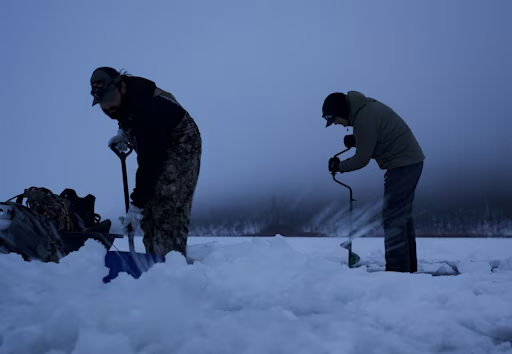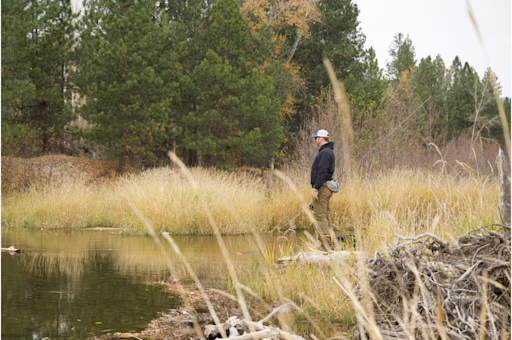Surf fishing fall stripers
Don't let lack of a boat keep you from catching stripers. Learn where and when to target stripers from the beach during the fall migration.
Share this article

The blitz is on. Stripers are making their yearly pilgrimage to southern waters, ambushing every baitball on their journey, and anglers all over the Atlantic are taking advantage. Fleets of fishing boats are in search of one of the greatest sportfish ever, but beach anglers have as much of a chance to set the hook.
Hundreds of miles of beach, from Maine to North Carolina, offer anglers an exceptional chance to take part in the striper migration. However, while the sea offers almost limitless possibilities, beach anglers need to be selective on where and how they are making each cast.
It's not as easy as stepping onto the closest public beach and making a cast, but below we will break down the basics of surf fishing for stripers from targeting bottom structure, to gear.
The Where

Stripers aren’t that much different from other bass species. Find the bait in edge habitat and you will find the stripers. Look for drop offs and troughs where the water depth increases dramatically and make sure you can get your line out that far. If the drop offs are too far out, you may need to either wade into the surf, or look for a more hospitable beach.
Bait fish, like shad, will find safety in the shallows and stripers will cruise on the edge sections looking to blitz baitfish and move back into the safeties of the deeps. Also look for the edge of whitewater and blue water as the crashing waves make baitfish vulnerable.
Estuaries and areas with running water moving into the salt also offer perfect havens for baitfish. Rain storms can offer a decided advantage to finding stripers, as well. Running water moving into the salt will become discolored after a good rain. Try targeting the edge of the discolored water and the blue salt water. The discolored water will be full of nutrients that will attract the baitfish and the predators will follow.
The best Fishbrain function to help

Open up your Fishbrain Map and start by selecting the Government Lands Layer. This will give you a starting idea of where you can access. Then turn on recent catches to see if there is any recent action and which time of day its been happening.
The What

Sardines, anchovies, squid and shad are your go to for a hungry striper. Sand eels are also a preferred striper meal and will assuredly work if you can time the sand eel run.
Artificial lures need to cover the different depths you will be fishing in this edge habitat. In lowlight conditions like early mornings and evenings, shad and other baitfish, which makes for a perfect chance for pencils and other poppers.
If the topwater isn’t happening you can’t go wrong with soft plastic shad lures and bucktail jigs with plenty of weight should be enough to properly cover the water column. Colors can be tricky to pick and some believe we as anglers put far too much stock into them. When in doubt, however, an off white lure is hard to beat.
Like we mentioned before, you need to cast far enough to fish transition zones. To do this you’ll need somewhere between an eight and ten foot surf rod. Make sure to run a 20-30 pound braided line that will hold up to the rigors of salt water, toothy predators and rocks. At the end of your line, you should be running a two to three foot flouro leader that ties onto your hook. The lack of stretch in fluorocarbon will help you set the hook at the end of a long distance cast, the low visibility will help with line shy fish on a clear day and the overall abrasion resistance will keep your hook tied in when that monster makes a run for the rocks.
Autumn weather is unpredictable and ocean temps will begin to drop, which may mean the need for waders. If you choose to pull on some stocking foot waders, make sure and grab some wading boots with spikes, or even use some attachable cleats. Wet rubber on ocean rocks is a recipe for a pair of waders full of saltwater, or worse.
The best Fishbrain function to help

Check out some local catches on your map and dive into the gear section for individual catches. Here you can see what kind of bai is working and compare that to the time of day, time of year and more.
The When

PC: Public Herald
Stripers will feed all day based on bait prevalence, but early mornings and the evening are particularly good times. Stripers are ambush predators that use their eyesight to ambush prey that cannot see nearly as well in the lowlight conditions.
Low light conditions like this will also lead to baitfish feeling safer toward the surface, which is why lures like pencil poppers work so well.
It's also important to monitor tides for high and low activity levels. Incoming tides will often push baitfish into a beach or estuary, bringing predators with it. Low tide feeding isn't usually as good as an incoming tide, but on specific beaches an outgoing tide can allow you to wade out farther to access current breaks, like rocks and reefs, that you couldn't cast too before.
Night is a popular time to surf fish as well, as large stripers will feel safe enough to travel into shallower water to feed on schools of baitfish. It's important to monitor moon phases, however as a full moon, or particularly bright moon, can make large bass shy away from the shallows.

PC: Public Herald
Anglers need also pay attention to the low pressure systems bringing in a cold front. The calm before an Atlantic storm can cause a feeding frenzy several days before the actual storm hits.
The best Fishbrain function to help

Check your weather forecast before you go. If you allow your GPS location on the app, you will get the tides for your area, weather, sunrise and set, pressure and more. These are all key ingredients to the perfect striper recipe.
Don’t let access to a boat stop you from enjoying one of the greatest fish migrations of the East Coast. Striped bass may be one of the greatest game fish to ever swim in saltwater and every angler deserves to feel one on their line and understand what makes them so respected. Get out and enjoy the fall run and let this fall season be your last hoorah before the colds of winter take over.
Now let’s go fishing. We’ll bring the sand eels.
If you haven't experienced the #1 fishing app worldwide, make sure and check out Fishbrain to see all the fish data, fishing spots, weather conditions you've been missing out on plus much more.

Download the Fishbrain app and access the best fishing spots in your area
Related blog posts
Master the hardwater season with advanced ice fishing tips . Learn how to find fish faster, refine your search and adjust presentations to catch more fish all winter long.

Your guide to Victoria’s best fish to catch in rivers, lakes, and coastal waters. Learn prime species, fishing tips, and key regulations

Learn how fish adapt as water temperatures cool from autumn to winter, including changes in behavior, metabolism, and habitat that help them survive.




